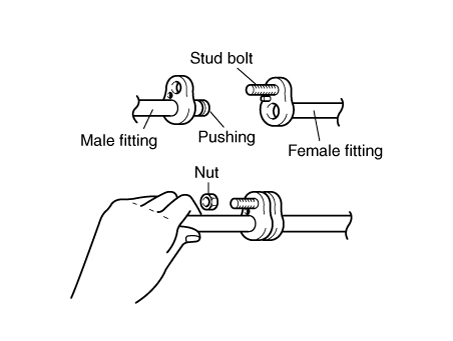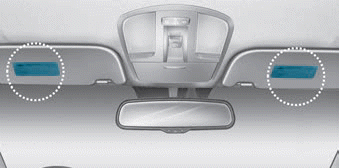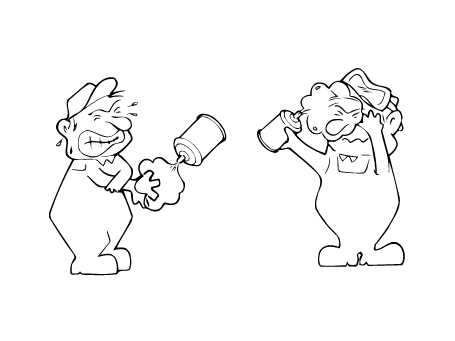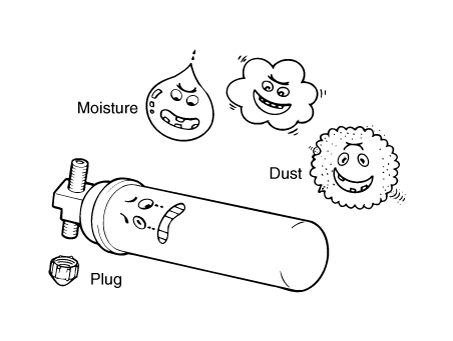Hyundai Ioniq: Air Conditioning System / General safety information and caution
Hyundai Ioniq (AE) 2017-2025 Service Manual / Heating, Ventilation and Air Conditioning / Air Conditioning System / General safety information and caution
| Instructions |
When Handling Refrigerant
| 1. | R-134a, R-1234yf liquid refrigerant is highly volatile. A drop on the skin of your hand could result in localized frostbite. When handling the refrigerant, be sure to wear gloves. |
| 2. | It is standard practice to wear goggles or glasses to protect your eyes, and gloves to protect your hands. If refrigerant splashes into your eyes, wash them with clean water immediately. |
| 3. | The R-134a, R-1234yf container is highly pressurized. Never leave it in a hot place, and check if storage temperature is below 52°C (126°F) |
| 4. | An electronic leak detector should be used to check the system for refrigerant leakage. Bear in mind that the R-134a, R-1234yf, upon coming into contact with flame, produces phosgene, a highly toxic gas. |
| 5. | Use only recommended lubricant for R-134a, R-1234yf systems. If lubricants other than the recommended one used, system failure may occur. |
| 6. | POE lubricant absorbs moisture from the atmosphere at a rapid rate, therefore the following precautions must be observed:
|
| 7. | Do not use the same A/C recovery / charging station as conventional belt-driven compressors. |
| 8. | Since the electric compressor uses high-voltage, you should use POE oil which have high volumetric resistivity.
|
| 9. | If an accidental discharge in the system occurs, ventilate the work area before resume of service.
|
When Replacing Parts on A/C System
| 1. | Never open or loosen a connection before discharging the system. |
| 2. | Seal the open fittings of components with a cap or plug immediately to prevent intrusion of moisture or dust. |
| 3. | Do not remove the sealing caps from a replacement component until it is ready to be installed. |
| 4. | Before connecting an open fitting, always install a new sealing ring. Coat the fitting and seal with refrigerant oil before making the connection.
|
When Installing Connecting Parts
Flange With Guide Pin
Check the new O-ring for damage (use only the specified) and lubricate by using compressor oil. Tighten the nut to the specified torque.

Handling Tubing and Fittings
The internal parts of the refrigeration system will remain in a state of chemical stability as long as pure moisture-free refrigerant and refrigerant oil are used. Abnormal amounts of dirt, moisture or air can upset the chemical stability and cause problems or serious damage.
The Following Precautions Must Be Observed
| 1. | When it is necessary to open the refrigeration system, have everything you will need to service the system ready so the system will not be left open any longer than necessary. |
| 2. | Cap or plug all lines and fittings as soon as they are opened to prevent entrance of dirt and moisture. |
| 3. | All lines and components in parts stock should be capped or sealed until they are ready to be used. |
| 4. | Never attempt to rebind formed lines to fit. Use the correct line for the installation you are servicing. |
| 5. | All tools, including refrigerant dispensing manifold, gauge set manifold and test hoses, should be kept clean and dry. |
Other information:
Hyundai Ioniq (AE) 2017-2025 Service Manual: Description and operation
DescriptionBlcok DiagramFunctions of Front View CameraFront View Camera supports the following functions using the information (lane, light source, vehicle and pedestrian) detected by the front view camera and the vehicle's signal information (CAN communication)...
Hyundai Ioniq (AE) 2017-2025 Owner's Manual: To Defrost Outside Windshield, Defogging Logic
To Defrost Outside Windshield 1. Set the fan speed to the highest (extreme right) position. 2. Set the temperature to the extreme hot (HI) position. 3. Press the defroster button (). 4. The outside (fresh) air position will be selected automatically...
Categories
- Manuals Home
- 1st Generation Ioniq Owners Manual
- 1st Generation Ioniq Service Manual
- Check brakes/Check regenerative brakes, Check Virtual Engine Sound System
- Reverse Parking Aid Function
- Folding the side view mirrors
- New on site
- Most important about car
Air Bag Warning Labels

Air bag warning labels, required by the U.S. National Highway Traffic Safety Administration (NHTSA), are attached to alert the driver and passengers of potential risks of the air bag system. Be sure to read all of the information about the air bags that are installed on your vehicle in this Owners Manual.
Copyright © 2025 www.hioniqae.com





